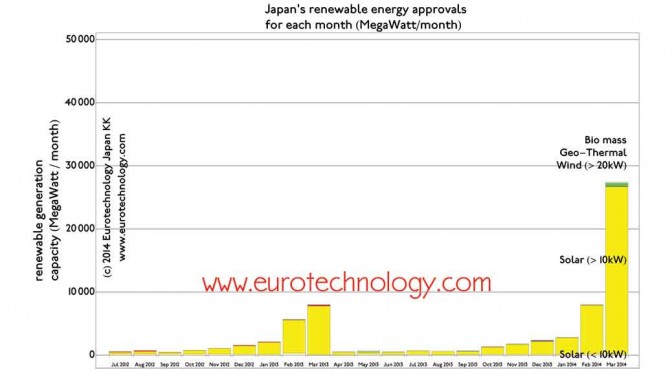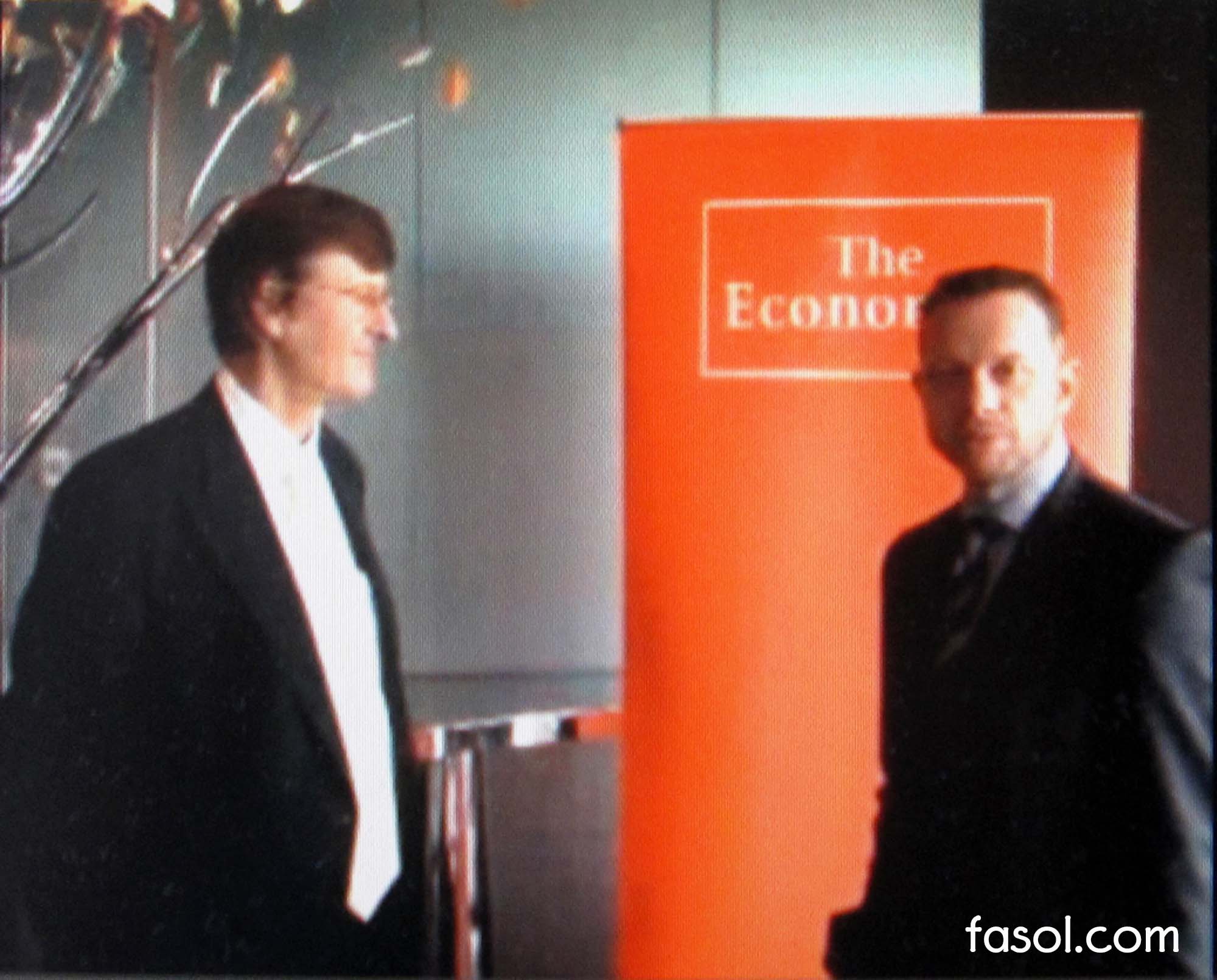Category: Japan’s energy sector
-
![Reduce your energy costs in Japan and Japan’s energy situation post-Fukushima [talk at EU Embassy Tokyo]](https://www.eurotechnology.com/b/wp-content/uploads/2017/05/IMG_7790_eu_2000_1000_HDR.jpg)
Reduce your energy costs in Japan and Japan’s energy situation post-Fukushima [talk at EU Embassy Tokyo]
Energy costs in Japan: A presentation to diplomats from the 28 EU countries (+ Norway and Switzerland) given at the EU Delegation in Tokyo on Thursday 18 May 2017 How can you reduce your energy bills? Energy costs in Japan, how to reduce energy costs, and the current energy situation in Japan post-Fukushima are inherently…
-

Toshiba nuclear write-off. BBC interview about Toshiba’s latest nuclear industry write-offs
Toshiba is expected to announce write-off provisions on the order of US$ 6 billion today Toshiba is on Tokyo Stock Exchange warning list for possible delisting in March 2017 by Gerhard Fasol This morning 7:30am I was interviewed on BBC TV Asia Business Report about an update of Toshiba’s ongoing crisis, which has been 20…
-

Angela Merkel in Japan to discuss renewable energy
German Federal Chancellor Angela Merkel in Japan March 9-10, 2015 Hopes for Japan and Germany share at least part of the path to renewable energy Germany’s Federal Chancellor Angela Merkel, Physicist with a PhD (Chancellor Angela Merkel’s PhD thesis is available here) and several scientific publications to her credit, visits Tokyo today Monday 9 March…
-

Japan in 2015 – analysis
Thoughts and analysis for 2015 Abenomics?! The trick of course is the third arrow, the reforms. Read what Professor Takeo Hoshi has to say about Abenomics, Japanese economist, who has worked his way up US Universities, and has now reached the position of Professor of Economics at Stanford University. By the way, here is my…
-

Nuclear safety – Niigata Governor Hirohiko Izumida
“Japan needs to prepare fourth level and fifth level defense-in-depth to nuclear accidents” Record, summary and commentary by Gerhard Fasol Governor Hirohiko Izumida: “Nuclear power operating companies should have their headquarters at the nuclear power plant in order to immediately take responsibility and respond.” Governor Hirohiko Izumida (泉田裕彦) is elected by the 2.3 million people…
-

Japan nuclear safety – Dr. Charles “Chuck” Casto’s view and lessons learnt
Dr Charles Casto: the Fukushima disaster changed my life. We cannot let this happen again anywhere in the world. Dr Charles “Chuck” Casto: leader of the US Government response to the Fukushima Dai Ichi Nuclear disaster When President Obama expanded the Operation Tomodachi to include the nuclear disaster, Dr. Charles Casto was selected to lead…
-
Storage battery testing laboratory for batteries up to 2 MegaWatt hours
Electricity storage is crucial for the efficient use of renewable energy, especially solar and wind Japan plans to build world’s largest storage battery testing laboratory Wind farms and solar plants deliver electricity not continuously, but output depends on weather, wind and solar illumination conditions. Battery storage technology is necessary to store solar electricity produced during…
-

Japan biomass electricity generation booming
Japan biomass electricity generation approaches 4 GigaWatt Renewables in Japan is not just solar… Looking superficially at Japan’s renewable energy sector, its easy to overestimate geo-thermal energy, and to underestimate biomass. Biomass electricity generation capacity is about 5 times higher than geo-thermal Currently the installed biomass electricity generation capacity is about 5 times higher than…
-

Solar Japan: Japan approves a full Germany worth of renewable energy in a single month
Solar Japan: some of the world’s most attractive feed-in-tariffs In the single month of March 2014 Japan approved almost as much renewable energy projects as all solar ever installed in Germany Japan’s ten regional electricity monopoly operators traditionally kept renewable energy below 1% following an unwritten rule. Tokyo Electric Power Company (TEPCO) kept renewable well…
-

Japan electricity sector disruption – new business models and deregulation overdue
Japan electricity regional operators’ income peaked about 10 years ago Japanese electricity companies’ business models face massive disruption by technology innovation and the Fukushima nuclear accident With the annual general shareholder meetings completed and financial results published, we have analyzed the financial results of Japan’s 10 regional electric power companies (plus several other Japanese electricity…
-

Japan’s electricity and new energy policy
Stockholm School of Economics at the Embassy of Sweden in Tokyo (Alfred Nobel Lecture Theatre) European Institute for Japanese Studies EIJS Announcement and summary on the website of Stockholm School of Economics. This talk is based on data from our reports: European Institute of Japanese Studies (EIJS) Academy Seminars About the talk: Japan’s electricity architecture…
-

What will happen with Japan’s nuclear power stations?
by Gerhard Fasol Watch The Economist interview on Japan’s energy policy. Read our report on Japan’s energy sector, and our report on Renewable energy in Japan. Many times, often several times a day, I get asked about what will happen with Japan’s nuclear power stations – today alone twice. So here is the answer I…
-

Japan’s new energy policy
Interview for The Economist “Keeping the lights on – deregulation and Japan’s energy mix” The interview is based on our reports: Japan energy policy – interview outline: Japan energy policy Question: Is the new energy policy of Japan’s Government an appropriate response to the situation or a missed opportunity Answer summary:The Government in its new…
-

Japan energy mix: Keeping the lights on in Japan – deregulation, new and renewable energy
Japan energy mix, smart grid, electricity deregulation – briefing by The Economist Corporate Network Economist Corporate Network held a breakfast briefing today April 24, 2014 for about 50 Japan-CEOs and executives. Shigeki (Sean) Miwa, General Manager of SoftBank’s CEO Office, and Representative Director & CEO of Bloom Energy Japan KK, and EVP of SB Energy…
-

IAEA recommends international cooperation for Fukushima decommissioning, Mr Yukiya Amano (天野之弥), Director General of the International Atomic Energy Agency (IAEA)
IAEA President Amano on Fukushima decommissioning by Gerhard Fasol It is wrong that Japan has all technology to decommission Fukushima Dai-ichi “It is wrong that Japan has all technology to decommission Fukushima Dai-ichi. The IAEA strongly recommends international cooperation for the decommissioning of Fukushima Dai-ichi nuclear power plants”, is the strongest statement Mr Yukiya Amano…
-

Ludwig Boltzmann – Energy, Entropy, Leadership by Gerhard Fasol (6th Ludwig Boltzmann Symposium)
Ludwig Boltzmann as leader (Gerhard Fasol, CEO of Eurotechnology Japan KK. Served as Associate Professor of Tokyo University, Lecturer at Cambridge University, and Manger of Hitachi Cambridge R&D Lab.) Keynote presented at the 6th Ludwig Boltzmann Symposium on February 20, 2014 at the Embassy of Austria in Tokyo. Ludwig Boltzmann, the scientist Ludwig Boltzmann’s greatest…
-

Japan Perspectives for 2014: can Abenomics succeed? Can Japan grow again? Can Japan solve the population crisis?
Will Abenomics succeed? Stanford Economics Professor Takeo Hoshi thinks that there is a 10% chance that Abenomics will succeed to put Japan on a 2%-3% economic growth path, while the most likely outcome will be 1% economic growth. Read our notes of Professor Hoshi’s talk in detail here. Can Japanese companies globalize? “Globalization” of course…
-

Scandinavian renewable energy conference in Tokyo
Was invited to attend the Scandinavian renewable energy conference in Tokyo. Topics covered: Electricity infrastructure, market and governance Electricity market reform in Japan Power of network and for green growth – learning from nordic experiences Nordic renewable energy sources Nordic solution for bio energy production Bioenergy from blue biomass Nordic way to increase efficiency of…
-

Japan nuclear free since Monday, Sept. 16, 2013, when the last reaction was switched off. Restart unclear.
Japan went 100% nuclear free since Monday, Sept. 16, 2013. When nuclear reactors will be restarted is totally unclear. Kansai Electric Power (KEPCO) on Sunday Sept 15, 2013 at 16:40 started to reduce power output of Japan’s last remaining active nuclear power reactor (Oi No. 4 reactor), and stopped operations of this reactor on Monday…
-

Feed in tariff Japan for renewable energy: approvals drying up?
Feed in tariff Japan for renewable energy are about three times higher than in Germany Approvals peaked just before the latest feed in tariff reduction The figures below show an overview of renewable energy sources currently installed and operational in Japan (the majority of which is water power), and also renewable energy projects approved by…
-

Japan LNG import costs increase 77.5% from 2011-2013
Japan LNG import costs – we analyze Japan’s official LNG import data Japan LNG import costs increase 77.5% from 2011-2013 Here we analyze Japan’s liquid natural gas (LNG) costs, which have been driven to record heights – mainly by the very high LNG prices Japan has to pay, and driven even higher by the low…
-

Japan energy – myths versus reality, mantra versus smart
A lecture a the Embassy of Sweden for the Stockholm School of Economics European Institute for Japanese Studies EIJS Outline of the lecture: Thank you to all those who attended the event “Japan’s energy – myths vs reality” at the Embassy of Sweden – an event organized by the European Institute for Japanese Studies of…
-

Japan’s Energy – Myths vs Reality
European Institute of Japanese Studies Academy Seminars presents: Japan’s Energy – Myths vs Reality” Speaker: Dr. Gerhard Fasol, President, Eurotechnology Japan K.K. Wednesday, June 19th, 2013 18:30 – 21:00 Embassy of Sweden, Alfred Nobel Auditorium Stockholm School of Economics, European Institute of Japanese Studies for details and registration click here Announcement on the webpage of…
-

94% of renewable energy projects approved under Japan’s feed-in-tariff programs are for solar energy generation
Japan’s feed in tariff for renewable energy Almost all projects are for solar energy Feed-in-tariffs for renewable energy where introduced in two stages in Japan. Large scale introduction of feed-in-tariffs (FIT) started with the Law entitled “Special measures concerning renewable energy electric power procurement by operators of electrical utilities law” which came into force on…
-

Growth in Japan: the SoftBank group
SoftBank gaining market share in Japan SoftBank market cap catching up with Docomo Mobile subscription data released last week show, that the SoftBank group continues to gain market share while incumbent NTT-docomo continues to lose market share – an upward trend for SoftBank, and a downward trend for NTT-docomo essentially unbroken since SoftBank acquired Vodafone-Japan…
-

Masayoshi Son: “I am a man – and I want to be Number 1”
SoftBank aims for global No. 1 position…acquiring SPRINT on the way to the top SoftBank: towards global No. 1 with a 300 year vision To understand SoftBank, and the planned SPRINT acquisition, you need to understand Masayoshi Son – and Masayoshi Son says: “I am a man – and I want to be Number 1”.…
-

US$ 15 billion losses for Japan’s electricity sector continue
On April 30 Japan’s electricity operators announced their financial results for the financial year that ended on March 31. Japan’s ten regional electricity operators again announced combined net losses in excess of US$ 15 billion for the Financial Year ending March 31, 2013, similar in size as the previous year: energy remains one of Japan’s…
-

Japan ought to be heaven for renewable energy (The Economist)
Industry Ministry METI announces renewable energy sources admitted to the feed-in-tariff program Reversing the decline of renewable energy in Japan A few days ago Japan’s industry ministry METI announced the most recent data on renewable energy sources in Japan admitted under the feed-in-tariff (FIT) regulations introduced on July 1, 2012. We have updated our report…
-

Japan to reverse decline of renewable energy – Renewables declined from 25% to 10%
Japan’s renewable energy generation is overwhelmingly water power Japan to reverse decline of renewable energy. The ratio of renewable power generation has decreased from 25% of total electricity generation in 1970 to 10% today. Extremely aggressive feed-in tariffs (FIT) for renewable energy introduced in July 2012 are showing first modest results to reverse this trend…
-

Japan gas imports: +77.5% from Jan ’11 to Jan ’13 – all-out efforts to reduce energy costs
Japan replaced almost all nuclear energy with liquid natural gas imports Increased LNG import costs due to declining yen Japan gas imports: Japan replaced almost all nuclear energy with liquid natural gas imports at very short notice. Japan pays far higher costs for liquid natural gas imports than most other regions in the world (find…